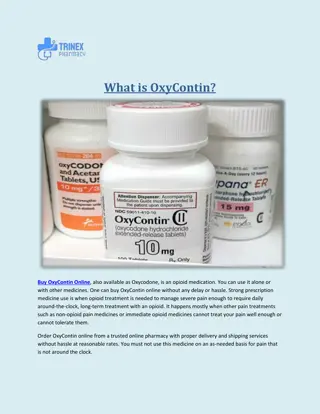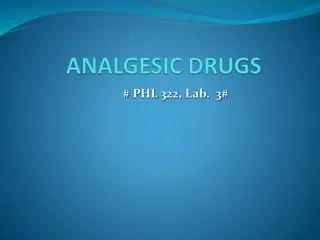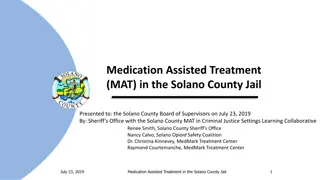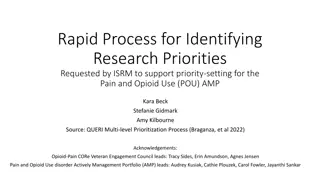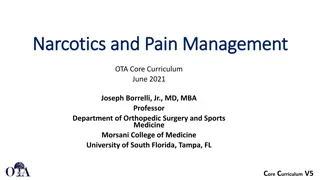Understanding Opioid and Non-Opioid Analgesics in Pain Management
Opioid analgesics, such as morphine, act in the central nervous system to relieve pain without affecting consciousness. They differ from non-opioid analgesics like aspirin in terms of CNS depression, pain type targeted, and addiction potential. Pain is a protective mechanism caused by tissue damage and chemical release, categorized as fast or slow based on pathophysiology. Differentiating neuropathic, nociceptive, acute, and chronic pain helps in understanding the nature and duration of pain for effective management.
Download Presentation

Please find below an Image/Link to download the presentation.
The content on the website is provided AS IS for your information and personal use only. It may not be sold, licensed, or shared on other websites without obtaining consent from the author. Download presentation by click this link. If you encounter any issues during the download, it is possible that the publisher has removed the file from their server.
E N D
Presentation Transcript
Opioid analgesics Dr. Kumari Anjana Assistant Professor Deptt. of Veterinary Pharmacology & Toxicology Bihar Veterinary College, Bihar Animal Sciences University, Patna
Opioid analgesics Are the drugs that significantly relieve pain by acting in central nervous system or on peripheral mechanisms without affecting consciousness. Agents that relieve pain by nonselective desensitization of tissues (local anesthetics), protective and soothing effects(demulcents), chemical neutralizations (antacids) or by alerting consciousness (general anesthetics) are not called analgesics. The analgesics are divided into 2 main groups: Opioid analgesics (narcotic or morphine like analgesics) Non- Opioid analgesics (non-narcotic or aspirin like analgesics)
Differences between Narcotic Analgesics & Non Narcotic Analgesics Narcotic Analgesics CNS depression- Narcosis. Deep seated (visceral) intense pain Antipyretic effect Absent. Anti-inflammatory effect Absent Antirheumatic, antiarthric and uricosuric or antigout effects- Absent. Toxicity high. Addiction high Non Narcotic Analgesics No significant CNS depression. Superficial pain Antipyretic effect Absent Anti-inflammatory effect Absent Antirheumatic, antiarthric and uricosuric or antigout effects- Absent Toxicity high. Addiction Absent.
Pain Algesia or pain is protective mechanism of body, it is produced by damage of tissue and subsequent liberation of various chemicals (bradykinin, serotonin, histamines, prostaglandins, Ach and substance-P). These chemicals interact with pain receptor (noceiceptors) present in skin or other tissues are all free nerve ending that respond to noxious stimuli. noceiceptors are very few in deeper tissue. Pain classify in two parts: Fast pain, Slow pain
Pain On the basis of Pathophysiology On the basis of duration Neuropathic Noceiceptive Acute Chronic Chronic: Pain that extends beyond the probable period of healing ( 3 or 6 months beyond inception) Depressed mood, health and functional capability Noceiceptive: Pain that arises from activation of sensory receptors (noceiceptors). E.g. Musculoskeletal disorders Acute: Usually associated with tissue damage, Increased autonomic nervous activity. Pain disappear with healing of injured tissue. Neuropathic: Pain arises from damage to peripheral or central nervous system tissue.
Differences between fast pain and slow pain Fast pain Slow pain It stars within 0.1 sec after application of stimulus. It is not felt in deeper tissue. Pain signals are transmitted from peripheral nerves to spinal cord by small diameter myelinated A fibers . Velocity of pain- 6-30m/s. It stars after a second or more and increases slowly. It is felt in both skin and deeper tissue or organ. Pain signals are transmitted by large diameter non - myelinated C fibers . Velocity of pain- 6-30m/s.
Neurophysiology of pain Nociceptors A-Delta fibres (Myelinated) C-Fibres (Unmyelinated) Dorsal Column Ventrolateral Column Post-central gyrus (Differentiation) Reticular activating System (Arousal) Thalamus Hypothalamus (Autonomic response) Fig. Schematic representation of pain pathways
Opioids Opium : opium is air dried milky exudates obtained from of poppy plant, Papaver somniferum, unripe seed capsules. Only two have clinical value ( morphine and codeine). It contains 32 alkaloids, divided into 2 distinct group: Benzylisoquinoline group Phenanthrene group E.g.: Papaverine, Noscapine and Narcine. E.g. Morphine, codeine and thebaine It has significant effect on CNS. CNS: depression or Excitation. Analgesia: insignificant Analgesia: significant except thebain. Spasmolytic. Spasmogenic. Addiction: uncommon. Addiction: common.
Morphine Morphine is principal alkaloid of opium.
Friedrich Wilhelm A. Serturner: A German Pharmacist Isolated Morphine in 1803 and named it after MORPHEUS , the Greek god of Dreams .
Opioid receptors Receptor type Physiological role Analgesia, indifference, cough suppression, respiratory depression, cardiovascular depression, physical dependence, hypothermia. m d Probably analgesia and indifference. k Analgesia, sedation and ataxia. s Euphoria or dysphorea, hallucinations, excitement and probably analgesia.
Mechanism of Analgesic Effect of Opioids The analgesic effect - is through their action on opioid receptors. These are G-protein coupled receptors and the action is involved through inhibition of adenylate cyclase causing decrease in intracellular second messenger cAMP. They are also linked to ion channels (G-protein coupled ion channels), interaction with which results in opening of K channels and inhibition of opening of Ca++ channels causing hyper polarization and non release of pain inducers. Thus the opioid analgesics block nociception neuronal pathway. Hence the pain sensation is not felt.
Pharmacological effect of morphine On CNS: Depression or Excitement depending on species. Depression in man, monkey and dog. Excitement in cat, cattle, sheep, got and horse. convulsions in a spinal dog (only spinal cord intact: stimulatory effect on spinal cord; hence not used to counteract strychnine convulsions). Has analgesic effect due to central (supraspinal) and peripheral actions, blocks the nociception transmission i.e. antinociception). Relieves acute or chronic deep seated pain (due to tissue injury, inflammation or tumors growth) without impairing motor activity.
On GIT (severe constipation): First morphine causes emptying of GIT through vomiting and defecation. persistent and intense spasmogenic effect on smooth muscles of intestines constriction of sphincters interfering with peristalsis causing delayed passage of ingesta, increased absorption of water and dryness of ingesta. suppresses the defecation reflex and causes constriction of anal sphincter causing severe constipation. On Respiration: Depression, accompanied by reduced sensitivity of respiratory centre to PCO2, Higher doses causes direct depression of medullary respiratory centre. Bronchoconstriction due to histamine release by morphine.
On CV system: No significant effect at analgesic doses. No effect on medullary vasomotor centre. Hypotension due to histamine release. At higher doses causes fall in BP and bradycardia due to depression of vasomotor centre. On Cough Centre: Potent antitussive (cough suppressant) by depression of cough centre. On Emetic Centre: Nausea and vomition through stimulation of CTZ at analgesic doses. Morphine causes simulated vomition following local application to the floor of IV ventricle in dogs from which GIT is removed, showing central emetic action, but not due to effect on GIT.
On Pupil (Eye): Marked dilatation in horse, monkey, sheep, cattle etc. Pin point constriction in man (diagnostic), dog, rat and rabbit. Bird s pupil size is not altered due to presence of nonresponsive skeletal muscle (sphincter muscle of iris). Body Temperature: Hypothermia in man, monkey, dog and rabbits, but in other animals hyperthermia. Hypothermia is due to release of 5-HT in hypothalamus which is reversed by TRH, (physiological antagonist of morphine). On Kidney: In dog morphine initially causes urination and later oligouria or anuria (release of ADH) increase in tone of urinary bladder and constriction of bladder sphincter. Neuroendocrine Action: Morphine interferes with hypothalamic activity and decreases the release of FSH, LH and ACTH increases the release of prolactin and GH.
Opioid receptor agonist and antagonist Opioid agonists - Morphine, Codeine, Hydromorphone, Oxymorphone, Meperidine, Methadone Opioid antagonists Naloxone, Diprenorphine, Naltrexone, Nalmefene Partial opioid agonists- Buprenorphine, Tramadol Opioid agonist antagonist (Mixed)- Nalbuphine, Pentazocine, Butorphanol, Nalorphine
Morphine Metabolism It is metabolized through conjugation in liver to form glucuronides morphine-3-glucuronide and morephine-6-glucuronide. The later has more analgesic effect than morphine and the former is morphine antagonist. The conjugates are excreted through bile in intestines (glucuronides are hydrolyzed in intestines and morphine is reabsorbed through enterohepatic recycling).
Clinical uses of morphine As analgesic In preanaesthetic medication. To relieve post-operative pain To treat Severe diarrhoea.
Morphine Toxicity Opium toxicity results due to grazing on stems or capsules of opium. The toxic signs are CNS excitation and constipation. Long term use of morphine in dogs causes addiction/physiological dependence, when sudden withdrawal results in appearance of abstinence syndrome characterized by hyper irritability, excessive motor activity (body shakes, writhing, jumping and sings of aggression), teeth chattering and weight loss. Addiction is common in man (in addition to above, also show frequent yawning, dilated pupil, fever, sweating, pilo-erection, nausea, diarrhea and insomnia. The subject is extremely restless and distressed and has strong craving for the drug).
CODEINE: It is used as the phosphate salt to relieve coughing , and as analgesic and cough suppressant in the man. DIAMORPHINE (Diacetylmorphine or Heroin): It is about 5 times as potent as morphine as an analgesic, narcotic and respiratory depressant. It has addictive properties. METHADONE: It is a synthetic compound, approx. equipotent with morphine as an analgesic. It is a powerful antitussives agent and used in horses & dog for cough suppression.
PETHIDINE (Meperidine): It is about 1/10th as active as morphine as an analgesic. It is less likely than morphine to produce narcosis, vasodepression, emesis and depression of the medullary cough and respiratory centers. Thus, it is more suitable for use in dog and pregnant animals than morphine. So, pethidine is certainly suitable for routine use in these species. APOMORPHINE: It is less potent than morphine as an analgesic and narcotic, but the central stimulant effects are increased. It is particularly potent as a centrally acting emetic acting as a stimulant on the CTZ of the medulla. It has been used as an emetic in the dog in cases of poisoning.
DEXTROMETHORPHAN: It lacks most of the properties of morphine including the analgesic, addictive, narcotic and spasmogenic actions. It does however, depresses the cough centre in the medulla and is used clinically as an antitussive in dogs when control of the dry productive cough is required. FENTANYL: It is approximately 50-100 times more potent than morphine as an analgesic. The main use of fentanyl is in neuroleptanalgesia.
Thebaine Derivatives: Etorphine : These drugs cause neuroleptanalgesia (analgesia + neurolepsia i.e. tranquility). Etorphine is 1000 times more potent than morphine and is used to immobilize wild animals for trapping. 1-2 mg/kg IM (dose for an elephant can be accommodated in a chart). Buprenorphine: Buprenorphine is a partial agonist on mu receptors. Dog 0.01-0.02 mg/kg SC twice day. Cat: 0.01 mg/kg SC or IM twice a day. Pig: 0.01-0.02 mg/kg IM 2-4 times in a day.














